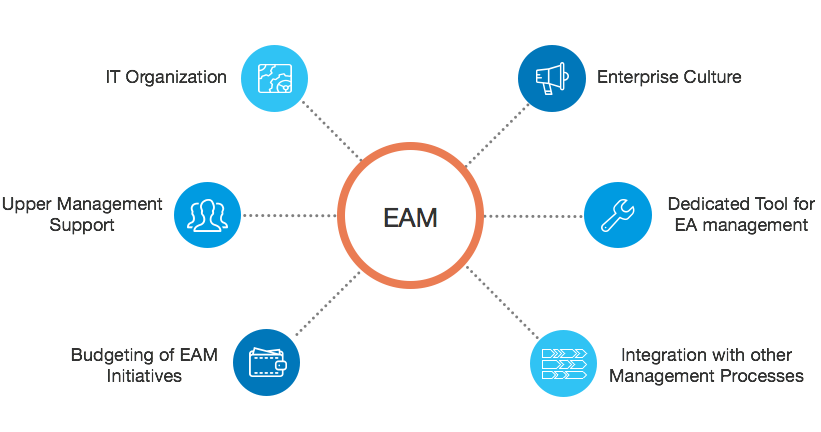Organizational factors like IT organization and budgeting need to be taken into account when establishing an EAM process [Buc10b].
Organizational Context of EAM Foundations
Enterprises seeking to establish an EAM function can choose from a variety of approaches. To determine how to design an EAM function for a certain enterprise, the organizational context in which the function will be embedded needs to be considered. The reason for that is, that most available approaches are explicitly or implicitly tailored to certain organizational contexts, in which they can be successfully applied [Buc10b].
The relevance of organizational influence factors manifests itself in the availability of pattern catalogs. The basic idea of pattern catalogs is to provide solution pattern for certain issues given the organizational context in which the solution will be applied. For example, mature organizations can select much more sophisticated EAM patterns, while smaller enterprises can focus on a small set of simple patterns which create value quickly [Ale+15].

Figure 1: A non-exhaustive list of organizational factors influencing the choice of an EAM function.
A non-exhaustive listing of possible organizational factors influencing the choice of an EAM function can be taken from Figure 1. First of all, the IT organization within an enterprise needs to be taken into account when selecting an EAM function. The IT organization could be structured in a centralized, a decentralized or a federate way. Additionally, the upper management support for the EAM function needs to be considered. Here it can be differentiated between a bottom-up initiative, where the EAM team initiates an EAM process, or a top-down initiative, where the upper management itself requests to establish an EAM function. Likewise, the budgeting of the EAM initiative constitutes an influence factor. The enterprise culture also affects the possible choices of EAM processes, since it can differ tremendously with regards to innovation management, communication style or the acceptance of formal models. Finally, the availability of a dedicated tool for EAM and the integration of the EAM function with other management functions and processes needs to be taken into account when selecting an EAM process [Buc10b].
Sources:
|
[Buc10b] |
S. Buckl. “A Design Theory Nexus for Situational Enterprise Architecture Management.” In: Proceedings of the 14th International IEEE Enterprise Distributed Object Computing Conference. IEEE Computer Society. IEEE Computer Society. Vitoria, Brazil, 2010, pp. 3–8. |
|
[Ale+15] |
P. Aleatrati Khosroshahi, M. Hauder, A. W. Schneider, and F. Matthes. Enterprise Architecture Management Pattern Catalog V2. Tech. rep. Munich, Germany: Technichal University of Munich (TUM), 2015. |